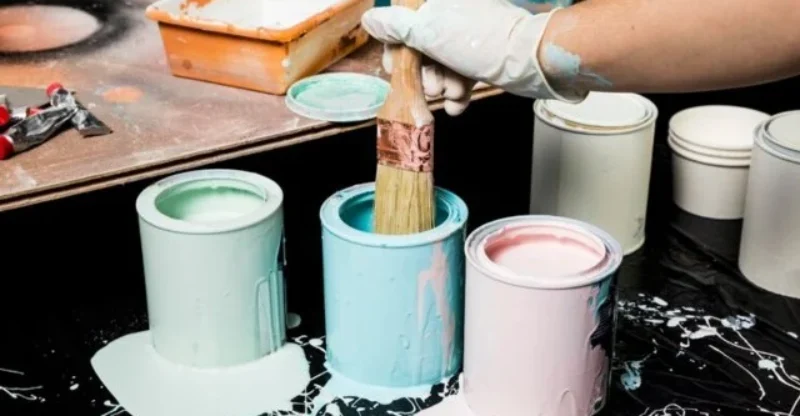What Is Milk Paint – Pros, Cons, Use & Application
Did you know that milk paint was used as far back as 49,000 years, dating back to ancient Egypt and colonial America?
This traditional Milk paint is a unique, non-toxic paint made from milk and lime, often with added pigments for color.
It’s known for its excellent adherence to porous and non-porous surfaces, especially when mixed with suitable bonding agents.
This paint has been used for thousands of years and is renowned for its durability. If protected from the elements, it often lasts centuries.
Whether you want to add a vintage touch to your furniture or create an authentic farmhouse look, milk paint can help you achieve the desired aesthetic.
Composition of Milk Paint: Ingredients and Properties
Understanding milk paint’s composition and unique properties is critical to unlocking its true potential. Explore its distinct matte finish and suitability for porous surfaces like raw wood.
The Natural Ingredients
Milk paint stands out for its use of natural ingredients, making it an eco-friendly choice for your painting projects.
The main components of milk paint include milk protein, earth pigments, and water. These ingredients combine to create a paint that is visually appealing and environmentally conscious.
The Matte Finish
One of the defining characteristics of milk paint is its unique matte finish. This finish gives surfaces a soft, velvety appearance that complements various décor styles.
Whether you’re aiming for a rustic farmhouse look or a more contemporary feel, milk paint’s matte finish adds a touch of sophistication to any project.
Suitable for Porous Surfaces
Milk paint is an excellent choice if you’re working with porous surfaces like raw wood. The natural properties of milk-based paint allow it to penetrate the surface, creating a durable bond.
It makes milk paint particularly well-suited for furniture refinishing, cabinetry, and other woodworking projects.
Pros and Cons of Using Milk Paint
Milk paint offers a range of benefits and considerations you should consider when deciding whether to incorporate it into your next project.
Here, we will explore the pros and cons of using milk paint, including its eco-friendly nature, ease of use in pre-mixed and powdered forms, and compatibility with DIY projects.
We will also touch upon the importance of a bonding agent for specific surfaces.
Pros of Milk Paint
- Eco-friendly: One significant advantage of milk paint is its environmentally friendly composition. Made from all-natural ingredients such as milk protein, clay, and earth pigments, milk paint is a great choice for those seeking a sustainable and non-toxic option for their projects.
- Versatility: Milk paint is incredibly versatile and can be used on various surfaces, including wood, metal, and even concrete. It adheres well to porous materials, providing a unique aged or vintage look that many DIY enthusiasts love.
- Pre-mixed and powdered forms: Milk paint is available in both pre-mixed and powdered forms, allowing you to choose the option that best suits your preferences and project requirements. Pre-mixed milk paint is convenient for quick and hassle-free application, while powdered milk paint offers greater control over color customization.
- DIY-friendly: Milk paint is famous for DIY projects due to its ease of use. Its simple application process requires minimal preparation, making it accessible for beginners and seasoned DIYers.
Cons of Milk Paint
- Sealant Requirement: Unlike some other paints, milk paint is porous. This means it absorbs and allows the passage of liquids and gases. A protective sealant is necessary to safeguard it from elements like dust, water, and grime. Environmentally friendly options such as beeswax, hemp oil, or finishing cream can be used to maintain the eco-friendly aspect of milk paint.
- Cost Considerations: While milk paint offers unique benefits, it has a higher price tag compared to other paint types. This makes it a less economical choice for large-scale painting projects. However, its unique properties can justify the cost of more minor, more detailed work.
- Preparation Process: Milk paint is typically sold in a powdered form that must be combined with water before application. It adds a step to the painting process compared to paints that are ready to use straight out of the can. The mixing process can vary between brands, with some recommending shaking, stirring, or even using a handheld mixer.
Modern Uses of Milk Paint & Application Techniques
Today, milk paint is used not only for antique furniture and replicas but also for modern-style pieces. The finish provided by milk paint has a depth of color and a mottled appearance that can give furnishings and rooms a rustic, shabby-chic character.
Here are some tips and techniques to help you get the most out of your milk paint.
1. Preparing the Surface
Before applying milk paint, it’s essential to prepare the surface properly. Ensure it is clean and free of dust, grease, and any existing finish. Lightly sanding the surface can help create a better bond between the paint and the material.
2. Mixing Milk Paint
Milk paint comes in powdered form and needs to be mixed with water or a bonding agent before use. You can also experiment with oil-based milk paint for added durability and a different finish. Just remember to follow the manufacturer’s instructions for the ideal mixing ratios.
3. Milk Paint vs. Chalk Paint
While milk paint and chalk paint may share similarities, they differ in application and finish. Milk paint is more versatile and easily mixed with other colors, whereas chalk paint often comes pre-mixed with a matte finish.
Consider your project requirements and desired outcome when choosing between the two.
4. Tips for a Successful Painting Project
- Apply milk paint in thin layers to avoid excessive buildup and cracking.
- Consider adding some milk to the paint mixture for a smoother application.
- If you prefer a more opaque finish, apply multiple coats of milk paint, allowing each layer to dry completely before applying the next.
- Experiment with different application techniques, such as using a brush, sponge, or roller, to achieve your desired texture and look.
- Seal the milk paint with a topcoat or wax to protect the finish and increase durability.



